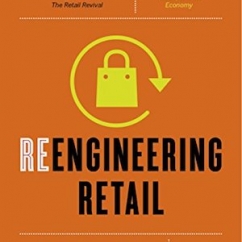Articles and News
Reengineering Retail: The Future of Selling in a Post-Digital World | June 20, 2018 (1 comment)

Las Vegas, NV—We all know retail is changing for a variety of reasons. But what does it mean for retailers to navigate the new landscape to thrive in business?
At the recent Plumb Club Retailer Breakfast in Las Vegas, noted “retail prophet” and futurist Doug Stephens delivered a presentation based on his latest book, Reengineering Retail: The Future of Selling in a Post-Digital World.
“How are consumers changing? How is technology impacting that?” he asked. In 2017, 8,642 stores closed in the United States. “Everybody is trying to figure out the disruption in marketplace. Everybody feels like it’s ‘retail Armageddon,” he said.
$2.3 trillion dollars were transacted online in global ecommerce in 2017, a 21% year-on-year increase. In the United States, e-commerce sales grew 16% year on year, while brick and mortar retailers thrilled over a 4% increase.

Doug Stephens
“60% of online sales are going to one company: Amazon,” said Stephens. But Amazon is more of a data, technology, and innovation company than a retail company, he explained. It has its own device ecosystem, its own music and video programs, and is investing more in original content than HBO. And data is why Amazon bought Whole Foods.
“People wondered why Amazon got into groceries. It’s a hard way to make a living: low margins, a rigorous industry, and fickle consumers. But where we see a bag of groceries, they see a bag of data that tells a lot about a household. How many of you casually look at what people in front of you are buying? How many of you judge people by what they’re buying? That’s exactly why Amazon wants to be in the grocery market. You have a pet? We can market pet foods to you. You have children? We can market children’s products.
“Amazon is a data company. Everything they do is about amassing data. Whole Foods [acquisition] was about distribution. If you look at Whole Foods locations, the map is almost identical to Amazon Prime memberships. Now Amazon has viable way of getting products to Prime customers much faster!”
What’s the challenge now? The challenge no longer is to try and convince people to buy online, even for luxury goods. Now the challenge is to get the things they bought to them in a shrinking window of time, said Stephens. Now a day or two seems forever.
Related Video: Andrea Hill Discusses How Consumers Shop Online for Jewelry Today
Returning to Amazon as the example, Stephens pointed out the company is putting [pick-up] lockers in university campuses and apartment complexes. Its talk of drone delivery is a little sci-fi, but what is happening in the background is that Amazon is becoming a shipping company, said Stephens. It has a truck fleet, a jet fleet, and Amazon Flex is like Uber drivers for Amazon. The new Amazon Key program even allows customers to remotely admit Amazon delivery people into their homes to put packages inside!
In 2017, he explained, Amazon called in representatives from dozens of brands for a three-day meeting. “We know you want better relationships with your consumers. Retail takes away margin, but we will offer you a better relationship with your consumers,” was the message. The result? Brands are running to Amazon, he said. But the sinister thing they don’t realize is that Amazon is tracking these brand names in the background, and anything that sells above the norm, those are products Amazon will consider making.
“Brands are answering clarion call and running to Amazon, while Jeff Bezos is laughing in background. If you think you’re selling something Amazon can’t, think again.”

Amazon might be smiling, but a lot of brands won't be so happy when they figure out the retail behemoth can start making competitive products, says Stephens.
The Amazon smile might even make Google grimace. “Retailers have been struggling with omnichannel, and meanwhile, Amazon is working on omnipresence.” Its goal is to put a digital presence in every home, constantly listening, constantly waiting for the next order, says Stephens, and that means of taking Google completely out of search. “
55% of product searches begin on Amazon, not on Google,” he said.
“But how do you replace product knowledge?” ask retailers. Simple, says Stephens: artificial intelligence (AI). “What’s even creepier is that we won’t care, as long as we’re getting the right answers!”
He also sees both Amazon and Alibaba opening stores, as other online pure-play brands have done. “They recognize you cannot fully actualize as brand without a physical and/or emotional connection to the customer. Real-life connection is very, very important. If physical stores are not important, why do people line up outside Apple stores for a phone they don’t even need and isn’t even that different from the one they already own?”
As we become more tethered to technologies, going out to a beautiful physical store is going to be more important, not less, he said. But we have to appreciate that everything about those spaces is going to be different. Till now, stores haven’t really changed in 200 years. From Le Bon Marche in Paris to outlet stores in Florida, retailers still plan and manage stores the same way they did in the Industrial Revolution.
Related: Where Is The Luxury Jewelry Market Going And Where Do You Fit In?
“The old role of stores was to merchandise products, offer information, and facilitate the purchase. Other than catalog shopping, consumers had no other choice. Today, if we’re interested in a watch, Amazon has 300,000 to choose from and 365 customer reviews on each watch. We have to stop thinking of stores as places to distribute products, and start thinking of them as places to distribute experiences with those products.”
But it isn’t binary, he said. Ecommerce growth doesn’t automatically mean the death of physical stores. He listed five commonalities that great brands in any category do that other brands don’t:
- Great brands engage consumers on a deeper level. All five senses are engaged. The store looks nice, but also smells great and feels great and sounds great. Great brands don’t build stores; they build stories about what they sell. What’s the story about what you sell? Look at Weiss watches, which is restoring prestige to American watchmaking. It’s a certified American movement by a Swiss-educated guy. That’s the story customers are compelled by. The first and most important aspect is that we engage consumers in stories.
- Create unique experiences by changing the script. Most experiences pretty much the same. Great brands recognize that and deliberately change the script of the experience. Before Starbucks, you just ordered a cup of coffee, but then you had to learn a whole new language around coffee. And consumers love it.
- Personalization and mass customization. “The third element makes a customer feel like you opened just for them. Tailor product recommendations to past preferences, and so forth. It works in the jewelry market, because you’re not giving customer just what everybody else has but adjusting it for them.”
- Surprise. Great brands find way to surprise you, do something you didn’t expect. DS in hotel in Mexico, got knock on door, lady came with gift of drinks and snacks. “That can take many forms: lectures, events, happenings going on in store. Gucci launched a store in Florence where customers are free to go to the first floor but if they want to go upstairs they have to pay 8 Euro.” Pay to shop? The second floor is a museum and the third floor is a cafe. “How can you inject surprise into the sales process?”
- It’s not good enough just to create nice experiences, it has to be repeatable. “Stop thinking about products and start thinking about production: theater, actors, script, set design, et cetera. True customer experience is not just how something looks, or product selection, but surprising, engaging, personalized, and repeatable. You won’t have to worry about conversion rates because everyone who comes in will be converts to your brands.”
“It is not the end of retail. It’s not retail Armageddon. It’s a time where you have to innovate. The answers lie in customer experience. You’ll find them if delve into moments and micro-moments of your experience. When you discover new ideas so innovative that it makes you sick to think about doing it, do it!
“Nobody needs what you sell. We have access to everything at our fingertips. But we do need HOW you sell it. Being a futurist is not about predicting the future, it’s about understanding what’s happening right now and engineering the future we want.”







